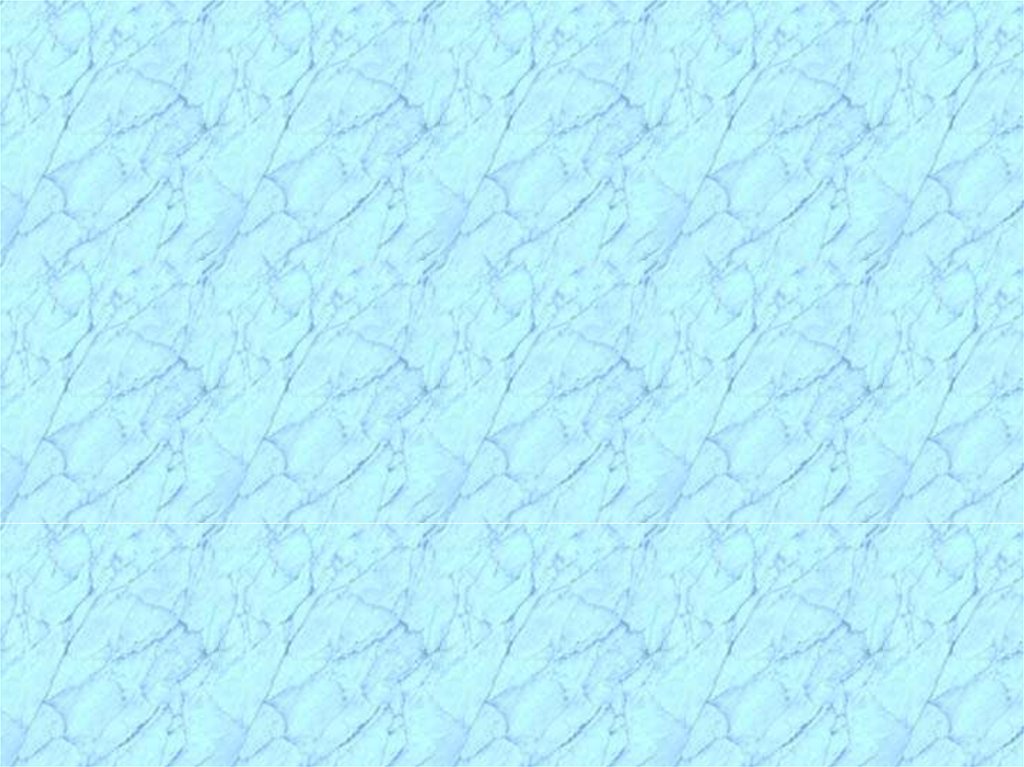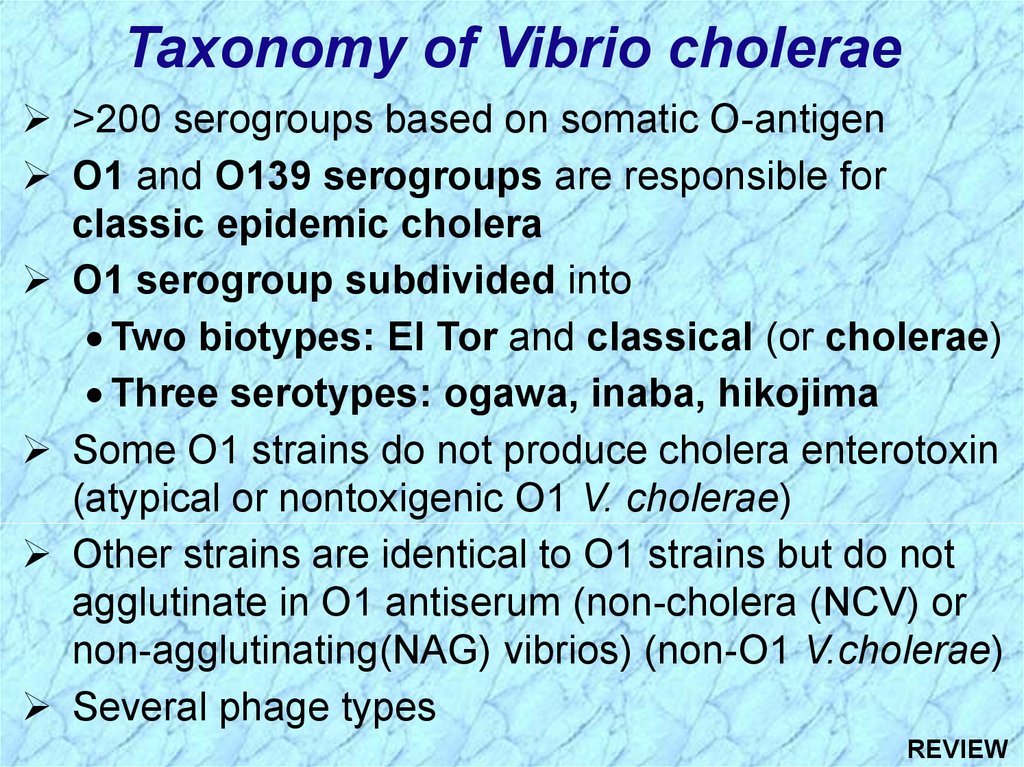Похожие презентации:
Vibrio, Aeromonas & Plesiomonas
1.
2.
Vibrio, Aeromonas& Plesiomonas
3.
General Characteristics of Vibrio,Aeromonas and Plesiomonas
Similarities to Enterobacteriaceae
Gram-negative
Facultative anaerobes
Fermentative bacilli
Differences from Enterobacteriaceae
Polar flagella
Oxidase positive
Formerly classified together as Vibrionaceae
Primarily found in water sources
Cause gastrointestinal disease
Shown not closely related by molecular methods
4.
Morphology & Physiology of VibrioComma-shaped (vibrioid) bacilli
V. cholerae, V. parahaemolyticus, V. vulnificus
are most significant human pathogens
Broad temperature & pH range for growth on media
18-37 C
pH 7.0 - 9.0 (useful for enrichment)
Grow on variety of simple media including:
MacConkey’s agar
TCBS (Thiosulfate Citrate Bile salts Sucrose) agar
V. cholerae grow without salt
Most other vibrios are halophilic
5.
Vibrio spp. (Family Vibrionaceae)Associated with Human Disease
6.
Epidemiology of Vibrio spp.Vibrio spp. (including V. cholerae) grow in
estuarine and marine environments worldwide
All Vibrio spp. can survive and replicate in
contaminated waters with increased salinity and
at temperatures of 10-30oC
Pathogenic Vibrio spp. appear to form symbiotic (?)
associations with chitinous shellfish which
serve as an important and only recently recognized
reservoir
Asymptomatically infected humans also serve
as an important reservoir in regions where cholera
is endemic
7.
Taxonomy of Vibrio cholerae>200 serogroups based on somatic O-antigen
O1 and O139 serogroups are responsible for
classic epidemic cholera
O1 serogroup subdivided into
Two biotypes: El Tor and classical (or cholerae)
Three serotypes: ogawa, inaba, hikojima
Some O1 strains do not produce cholera enterotoxin
(atypical or nontoxigenic O1 V. cholerae)
Other strains are identical to O1 strains but do not
agglutinate in O1 antiserum (non-cholera (NCV) or
non-agglutinating(NAG) vibrios) (non-O1 V.cholerae)
Several phage types
8.
Epidemiology of Vibrio choleraeCholera recognized for more than two millennia
with sporadic disease and epidemics
Endemic in regions of Southern and Southeastern
Asia; origin of pandemic cholera outbreaks
Generally in communities with poor sanitation
Seven pandemics (possible beginning of 8th)
since 1817 attributable to increased world travel
Cholera spread by contaminated water and food
Human carriers and environmental reservoirs
9.
Recent Cholera Pandemics7th pandemic:
V. cholerae O1 biotype El Tor
Began in Asia in 1961
Spread to other continents in 1970s and 1980s
Spread to Peru in 1991 and then to most of
South & Central America and to U.S. & Canada
By 1995 in the Americas, >106 cases; 104 dead
8th pandemic (??)
V. cholerae O139 Bengal is first non-O1 strain
capable of causing epidemic cholera
Began in India in 1992 and spread to Asia,
Europe and U.S.
Disease in humans previously infected with O1
strain, thus no cross-protective immunity
10.
Pathogenesis of V.choleraeIncubation period: 2-3 days
High infectious dose: >108 CFU
103 -105 CFU with achlorhydria or hypochlorhydria
(lack of or reduced stomach acid)
Abrupt onset of vomiting and life-threatening
watery diarrhea (15-20 liters/day)
As more fluid is lost, feces-streaked stool
changes to rice-water stools:
Colorless
Odorless
No protein
Speckled with mucus
11.
Pathogenesis of V.cholerae (cont.)Cholera toxin leads to profuse loss of fluids and
electrolytes (sodium, potassium, bicarbonate)
Hypokalemia (low levels of K in blood)
Cardiac arrhythmia and renal failure
Cholera toxin blocks uptake of sodium &
chloride from lumen of small intestine
Death attributable to:
Hypovolemic shock (due to abnormally low
volume of circulating fluid (plasma) in the body)
Metabolic acidosis (pH shifts toward acid side
due to loss of bicarbonate buffering capacity)
12.
Treatment & Prevention of V. choleraeUntreated: 60% fatality
Treated: <1% fatality
Rehydration & supportive therapy
Oral
Sodium chloride (3.5 g/L)
+ Potassium chloride (1.5 g/L)
+ Rice flour (30-80g/L)
+ Trisodium citrate (2.9 g/L)
Intravenous (IV)
Doxycycline or tetracycline (Tet resistance may
be developing) of secondary value
Water purification, sanitation & sewage
treatment
Vaccines
13.
Virulence Factors Associated withVibrio cholerae O1 and O139
14.
Two Broad Classes of Bacterial ExotoxinsIntracellular Targets: A-B dimeric (two
domain) exotoxins: (prototype is diphtheria toxin
of Corynebacterium diphtheriae):
Bipartite structure: Binding domain (B) associated with
absorption to target cell surface and transfer of active
component (A) across cell membrane; once internalized,
domain (A) enzymatically disrupts cell function
Receptor-mediated endocytosis (host cell uptake and
internalization of exotoxin)
ADP-ribosylation of intracellular target host molecule
Cellular Targets: Cytolytic exotoxins (usually
degradative enzymes) or cytolysins: hemolysis,
tissue necrosis, may be lethal when administered
intravenously
15.
Cholera Toxin (A2-5B)(Vibrio cholerae)Chromosomally-encoded; Lysogenic phage
conversion; Highly conserved genetic sequence
Structurally & functionally similar to ETEC LT
B-subunit binds to GM1 ganglioside receptors in
small intestine
Reduction of disulfide bond in A-subunit activates
A1 fragment that ADP-ribosylates guanosine
triphosphate (GTP)-binding protein (Gs) by
transferring ADP-ribose from nicotinamide adenine
dinucleotide (NAD)
ADP-ribosylated GTP-binding protein activates
adenyl cyclase leading to an increased cyclic
AMP (cAMP) level and hypersecretion of fluids
and electrolytes
16.
Mechanismof Action of
Cholera
Toxin
NOTE: In step #4,
uptake of Na+ and Clfrom the lumen is also
blocked.
HCO3- = bicarbonate
which provides
buffering capacity.
1
2
3
4
17.
Mechanism of Action of Cholera Toxin18.
Heparin-binding epidermal growthfactor on heart & nerve surfaces
19.
20.
Summary of Vibrioparahaemolyticus
Infections
21.
Summary ofVibrio vulnificus
Infections
22.
Virulence Factors Associated withNon-cholerae Vibrios
(Kanagawa positive)
23.
Laboratory Identification of VibriosTransport medium - Cary-Blair semi-solid agar
Enrichment medium - alkaline peptone broth
• Vibrios survive and replicate at high pH
• Other organisms are killed or do not multiply
Selective/differential culture medium - TCBS agar
• V. cholerae grow as yellow colonies
Biochemical and serological tests
24.
25.
Characteristics and Epidemiology ofAeromonas (Family Aeromonadaceae)
Gram-negative facultatively anaerobic bacillus
resembling members of the Enterobacteriaceae
Motile species have single polar flagellum
(nonmotile species apparently not associated with
human disease)
16 phenospecies: Most significant human
pathogens A. hydrophila, A. caviae, A. veronii
biovar sobria
Ubiquitous in fresh and brackish water
Acquired by ingestion of or exposure to
contaminated water or food
26.
Clinical Syndromes of AeromonasAssociated with gastrointestinal disease
Chronic diarrhea in adults
Self-limited acute, severe disease in children
resembling shigellosis with blood and leukocytes
in the stool
3% carriage rate
Wound infections
Opportunistic systemic disease in immunocompromised
Putative virulence factors include: endotoxin;
hemolysins; eneterotoxin; proteases; siderophores;
adhesins
27.
AfimbriatedAeromonas hydrophila
Nonadherent
Afimbriated
Bacterial Cells
and Buccal Cells
28.
FimbriatedAeromonas hydrophila
Adherent
Fimbriated
Bacterial Cells
and Buccal Cells
29.
Characteristics of PlesiomonasFormerly Plesiomonadaceae
Closely related to Proteus & now classified as
Enterobacteriaceae despite differences:
Oxidase positive
Multiple polar flagella (lophotrichous)
Single species: Plesiomonas shigelloides
Isolated from aquatic environment (fresh or
estuarine)
Acquired by ingestion of or exposure to
contaminated water or seafood or by exposure
to amphibians or reptiles
Self-limited gastroenteritis: secretory, colitis or
chronic forms
Variety of uncommon extra-intestinal infections
30.
Characteristics of Aeromonas andPlesiomonas Gastroenteritis
Epidemiological
Features
Aeromonas
Plesiomonas
Fresh or brackish water
Fresh or brackish water
Contaminated water or food
Contaminated water or food
Blood/WBCs in Stool
Present
Present
Present
Absent
Absent
Present
Present
Present
Absent
Present
Pathogenesis
Enterotoxin (??)
Invasiveness
Natural Habitat
Source of Infection
Clinical Features
Diarrhea
Vomiting
Abdominal Cramps
Fever
31.
REVIEW32.
Vibrio spp. (Family Vibrionaceae)Associated with Human Disease
REVIEW
33.
Epidemiology of Vibrio spp.Vibrio spp. (including V. cholerae) grow in
estuarine and marine environments worldwide
All Vibrio spp. can survive and replicate in
contaminated waters with increased salinity and
at temperatures of 10-30oC
Pathogenic Vibrio spp. appear to form symbiotic (?)
associations with chitinous shellfish which
serve as an important and only recently recognized
reservoir
Asymptomatically infected humans also serve
as an important reservoir in regions where cholera
is endemic
REVIEW
34.
Taxonomy of Vibrio cholerae>200 serogroups based on somatic O-antigen
O1 and O139 serogroups are responsible for
classic epidemic cholera
O1 serogroup subdivided into
Two biotypes: El Tor and classical (or cholerae)
Three serotypes: ogawa, inaba, hikojima
Some O1 strains do not produce cholera enterotoxin
(atypical or nontoxigenic O1 V. cholerae)
Other strains are identical to O1 strains but do not
agglutinate in O1 antiserum (non-cholera (NCV) or
non-agglutinating(NAG) vibrios) (non-O1 V.cholerae)
Several phage types
REVIEW
35.
Epidemiology of Vibrio choleraeCholera recognized for more than two millennia
with sporadic disease and epidemics
Endemic in regions of Southern and Southeastern
Asia; origin of pandemic cholera outbreaks
Generally in communities with poor sanitation
Seven pandemics (possible beginning of 8th)
since 1817 attributable to increased world travel
Cholera spread by contaminated water and food
Human carriers and environmental reservoirs
REVIEW
36.
Summary ofVibrio cholerae
Infections
REVIEW
37.
Summary ofVibrio cholerae
Infections (cont.)
REVIEW
38.
Pathogenesis of V.cholerae (cont.)Cholera toxin leads to profuse loss of fluids and
electrolytes (sodium, potassium, bicarbonate)
Hypokalemia (low levels of K in blood)
Cardiac arrhythmia and renal failure
Cholera toxin blocks uptake of sodium &
chloride from lumen of small intestine
Death attributable to:
Hypovolemic shock (due to abnormally low
volume of circulating fluid (plasma) in the body)
Metabolic acidosis (pH shifts toward acid side
due to loss of bicarbonate buffering capacity)
REVIEW
39.
Virulence Factors Associated withVibrio cholerae O1 and O139
REVIEW
40.
Mechanism of Action of Cholera ToxinREVIEW
41.
42.
Summary of Vibrioparahaemolyticus
Infections
REVIEW
43.
Summary ofVibrio vulnificus
Infections
REVIEW
44.
Virulence Factors Associated withNon-cholerae Vibrios
(Kanagawa positive)
REVIEW
45.
46.
Characteristics and Epidemiology ofAeromonas (Family Aeromonadaceae)
Gram-negative facultatively anaerobic bacillus
resembling members of the Enterobacteriaceae
Motile species have single polar flagellum
(nonmotile species apparently not associated with
human disease)
16 phenospecies: Most significant human
pathogens A. hydrophila, A. caviae, A. veronii
biovar sobria
Ubiquitous in fresh and brackish water
Acquired by ingestion of or exposure to
contaminated water or food
REVIEW
47.
Clinical Syndromes of AeromonasAssociated with gastrointestinal disease
Chronic diarrhea in adults
Self-limited acute, severe disease in children
resembling shigellosis with blood and leukocytes
in the stool
3% carriage rate
Wound infections
Opportunistic systemic disease in immunocompromised
Putative virulence factors include: endotoxin;
hemolysins; eneterotoxin; proteases; siderophores;
adhesins
REVIEW
48.
Formerly PlesiomonadaceaeClosely related to Proteus & now classified as
Enterobacteriaceae despite differences:
Oxidase positive
Multiple polar flagella (lophotrichous)
Single species: Plesiomonas shigelloides
Isolated from aquatic environment (fresh or
estuarine)
Acquired by ingestion of or exposure to
contaminated water or seafood or by exposure
to amphibians or reptiles
Self-limited gastroenteritis: secretory, colitis or
chronic forms
Variety of uncommon extra-intestinal infections
REVIEW
Characteristics of Plesiomonas
49.
Characteristics of Aeromonas andPlesiomonas Gastroenteritis
REVIEW


















































 Биология
Биология








